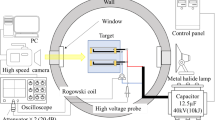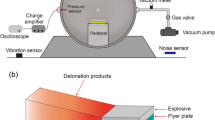Abstract
To study the shock wave initiation characteristics of 2,4,6-trinitrotoluene (TNT) under different charging types, the shock wave pressure and shock wave attenuation of standard Pentolite explosives under different diaphragm thicknesses were quantitatively studied using the ion probe method. The gap tests of three explosives were carried out, including pressed TNT without restraint, pressed TNT with steel pipe restraint, and cast TNT with steel pipe restraint. The shock wave initiation pressures of TNT under the three different conditions were compared. Moreover, combined with the numerical simulation technology, the critical initiation pressure and the pressure cloud diagram of the gap test of TNT were obtained, and the dynamic change process of the shock wave in the diaphragm was acquired, which was difficult to measure in the experiments. The results showed that the critical initiation pressure of pressed TNT was significantly lower than that of cast TNT and that restraint can reduce the measured critical initiation pressure of TNT under certain conditions. Therefore, the research results may provide a basis for the damage range of TNTs with different charging types and the determination of the safety protection distance of shock wave initiation.










Similar content being viewed by others
Data availability statement
All data, models, or codes used during the study are available from the corresponding author by request.
References
Zhang, X.Q., Yuan, J.N., Selvaraj, G., Ji, G.F., Wei, D.Q.: Towards the low-sensitive and high-energetic co-crystal explosive CL-20/TNT: from intermolecular interactions to structures and properties. Phys. Chem. Chem. Phys. 20(5), 17253–17261 (2018). https://doi.org/10.1039/C8CP01841C
Lease, N., Kay, L.M., Brown, G.W., Manner, V.W.: Modifying nitrate ester sensitivity properties using explosive isomers. Cryst. Growth Des. 19(11), 6708–6714 (2019). https://doi.org/10.1021/acs.cgd.9b01062
Hang, G.Y., Yu, W.L., Tao, W., Wang, J.T.: Theoretical investigations into effects of adulteration crystal defect on properties of CL-20/TNT cocrystal explosive. Comput. Mater. Sci. 156, 77–83 (2019). https://doi.org/10.1016/j.commatsci.2018.09.027
Dattelbaum, D.M., Sheffield, S.A., Bartram, B.D., Gibson, L.L., Bowden, R.R., Schilling, B.F.: The shock sensitivities of nitromethane/methanol mixtures. J. Phys. Conf. Ser. 500(18), 182009 (2014). https://doi.org/10.1088/1742-6596/500/18/182009
Xue, X.G., Wen, Y.S., Long, X.P., Li, J.S., Zhang, C.Y.: Influence of dislocations on the shock sensitivity of RDX: molecular dynamics simulations by reactive force field. J. Phys. Chem. C 119(24), 13735–13742 (2015). https://doi.org/10.1021/acs.jpcc.5b03298
Belik, A.V., Potemkin, V.A., Sluka, S.N.: Shock sensitivity analysis of organic explosives. Combust. Explos. Shock Waves 35(5), 562–567 (1999). https://doi.org/10.1007/BF02674502
Tan, B., Long, X., Peng, R., Li, H., Jin, B., Chu, S.: On the shock sensitivity of explosive compounds with small-scale gap test. J. Phys. Chem. A 115(38), 10610–10616 (2011). https://doi.org/10.1021/jp204814f
Jing, P.L., Lochert, I.J., Daniel, M.A., Franson, M.D.: Shock sensitivity studies for PBXN-109. Propell. Explos. Pyrot. 41(3), 562–571 (2016). https://doi.org/10.1002/prep.201500336
Balagansky, I., Stepanov, A.: Numerical simulation of composition b high explosive charge desensitization in gap test assembly after loading by precursor wave. Shock Waves 26(2), 109–115 (2016). https://doi.org/10.1007/s00193-015-0584-1
Nandlall, D.: Determination of a measure of sensitivity to shock detonate an explosive as a function of its shock parameters. Propell. Explos. Pyrot. 44(11), 1423–1431 (2019). https://doi.org/10.1002/prep.201800383
Zhang, J., Jackson, T.L.: Effect of microstructure on the detonation initiation in energetic materials. Shock Waves 29(2), 327–338 (2019). https://doi.org/10.1007/s00193-017-0796-7
Kim, B., Park, J., Yoh, J.J.: Analysis on shock attenuation in gap test configuration for characterizing energetic materials. J. Appl. Phys. 119(14), 605–639 (2016). https://doi.org/10.1063/1.4945777
Giglmaier, M., Quaatz, J.F., Gawehn, T., Gülhan, A., Adams, N.A.: Numerical and experimental investigations of pseudo-shock systems in a planar nozzle: impact of bypass mass flow due to narrow gaps. Shock Waves 24(2), 139–156 (2014). https://doi.org/10.1007/s00193-013-0475-2
Paton, R.T., Skews, B.W., Rubidge, S., Snow, J.: Imploding conical shock waves. Shock Waves 23(4), 317–324 (2013). https://doi.org/10.1007/s00193-012-0386-7
Qiang, H.F., Liu, Y.X., Wang, D.D., Wang, X.R., Geng, B., Wang, G.: Numerical simulation study of composite solid propellant small scale gap test. AIP Adv. 11(1), 1–17 (2021). https://doi.org/10.1063/5.0039853
Sudac, D., Valkovic, V., Nad, K., Obhodas, J.: The underwater detection of TNT explosive. IEEE Trans. Nucl. Sci. 58(2), 547–551 (2011). https://doi.org/10.1109/TNS.2011.2112671
Tochilin, S.N., Komissarov, P.V., Basakina, S.S.: Assessment of errors in determining the TNT equivalency of air explosions. Russ. J. Phys. Chem. B 14(4), 631–635 (2020). https://doi.org/10.1134/S1990793120040259
Dubovik, A.V.: Approximate method for calculating the impact sensitivity indices of solid explosive mixtures. Combust. Explos. Shock Waves 37(1), 99–105 (2001). https://doi.org/10.1023/A:1002829028043
Kuhl, A.L., Bell, J.B., Beckner, V.E., Reichenbach, H.: Gasdynamic model of turbulent combustion in TNT explosions. Proc. Combust. Inst. 33(2), 2177–2185 (2011). https://doi.org/10.1016/j.proci.2010.07.085
Bassett, W.P., Johnson, B.P., Dlott, D.D.: Hot spot chemistry in several polymer-bound explosives under nanosecond shock conditions. Propell. Explos. Pyrot. 45(2), 338–346 (2020). https://doi.org/10.1002/prep.201900249
Belskii, B.M.: Model for TNT combustion under shock compression. Combust. Explos. Shock Waves 48(3), 328–334 (2012). https://doi.org/10.1134/S0010508212030100
Bowden, P.R., Chellappa, R.S., Dattelbaum, D.M., Manner, V.W., Mack, N.H., Liu, Z.: The high-pressure phase stability of 2,4,6-trinitrotoluene (TNT). J. Phys. Conf. Ser. 500(5), 052006 (2014). https://doi.org/10.1088/1742-6596/500/5/052006
Campbell, A.W., Davis, W.C., Ramsay, J.B., Travis, J.R.: Shock initiation of solid explosives. Phys. Fluids 4(4), 511 (1961). https://doi.org/10.1063/1.1706354
Liu, H., He, Y.H., Li, J.L., Zhou, Z.X.: ReaxFF molecular dynamics simulations of shock induced reaction initiation in TNT. AIP Adv. 9(1), 015202 (2019). https://doi.org/10.1063/1.5047920
Cao, W., He, Z.Q., Chen, W.H.: Experimental and numerical study on the afterburning effect of TNT. Mater. Sci. Forum 767, 46–51 (2013). https://doi.org/10.4028/www.scientific.net/MSF.767.46
Author information
Authors and Affiliations
Corresponding author
Additional information
Communicated by P. Hazell.
Publisher's Note
Springer Nature remains neutral with regard to jurisdictional claims in published maps and institutional affiliations.
Rights and permissions
Springer Nature or its licensor (e.g. a society or other partner) holds exclusive rights to this article under a publishing agreement with the author(s) or other rightsholder(s); author self-archiving of the accepted manuscript version of this article is solely governed by the terms of such publishing agreement and applicable law.
About this article
Cite this article
Wang, J.H., Xia, M. & Jiang, N. Critical shock initiation characteristics of TNT with different charging types. Shock Waves 33, 39–49 (2023). https://doi.org/10.1007/s00193-022-01115-0
Received:
Accepted:
Published:
Issue Date:
DOI: https://doi.org/10.1007/s00193-022-01115-0




